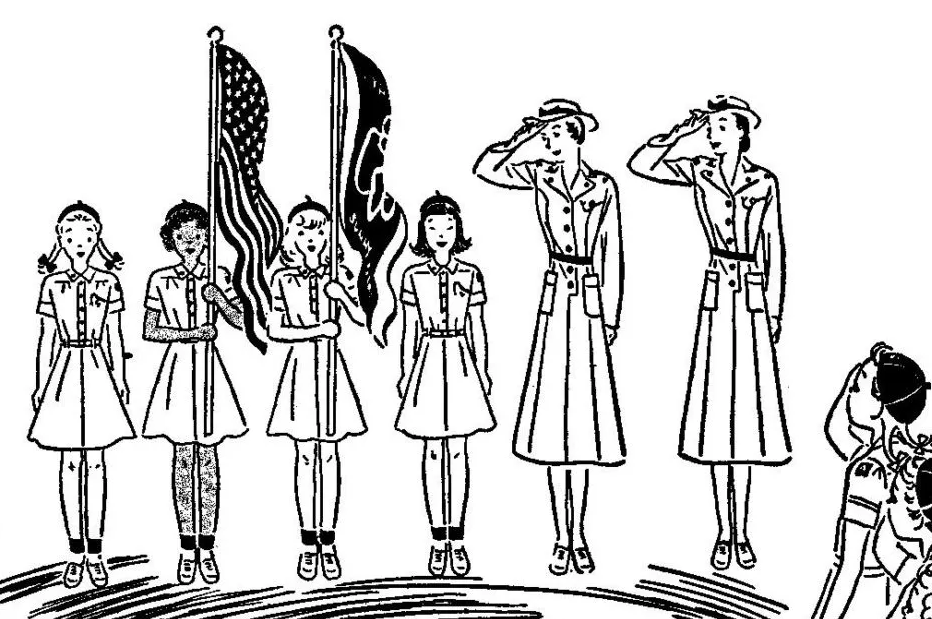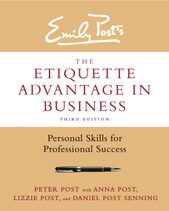
Flag Etiquette

Disclosure: This post may contain affiliate links, meaning if you decide to make a purchase via the links, The Emily Post Institute may earn a small commission at no additional cost to you. See the Emily Post Institute full disclosure statement for more info.
The American flag is a symbol of national pride and unity in the United States. Displaying the flag properly is a way to honor America and the history it represents. Also known as "Old Glory" or the "Stars and Stripes," the American flag is treated with the same respect as a living entity and never dips to any person or thing. It is the premier symbol of patriotism and proclaims America's commitment to freedom.
The rules and customs that surround the flag's care and display are often taught in elementary school. Others learn flag etiquette when they join the military. The United States Flag Code establishes advisory rules for the display and care of the national flag of the United States of America.
After the terrorist attacks of September 11, 2001, millions of Americans experienced a renewed interest in the correct way to display the flag as a symbol of patriotism and unity. Sometimes, the American flag is a symbol used to ignite a national dialogue on difficult subjects such as racism. All United States citizens can learn the etiquette surrounding the American flag to ensure it is treated with the respect it deserves.
How to Display the Flag
American flags are out in force on holidays—especially the Fourth of July, Memorial Day, Flag Day (June 14), and Veterans' Day (November 11). It's correct to fly the flag every day of the year, weather permitting, between sunrise and sunset. It may also be flown at night as part of a patriotic display as long as it is illuminated. Customarily the flag is not flown in inclement weather unless it is made of all-weather material.
The term "union" refers to the blue field with white stars that represent the 50 states. This section of the flag is also known as the "canton." When the flag is displayed in various positions, the placement of the union is an important aspect of flag etiquette. The other part of the American flag, is the "field" or the stripes. The field consists of thirteen horizontal stripes, seven red and six white, which represent the original thirteen colonies that declared independence from Britain.
When the flag is flown from a staff projecting horizontally or at an angle from a window sill, balcony or the front of a building, the union of the flag should go all the way to the peak of the staff, except when flown at half-staff.
The flag is suspended vertically over a street:
- When the flag is suspended vertically over an east-west street, the union should be to the north.
- When the flag is suspended vertically over a north-south street, the union should be to the east.
When the flag is displayed but not flown from a staff, it should be hung flat against a wall (not tucked or draped), whether indoors or out. The union should be uppermost and to the flag's own right, meaning on the observer's left. In a window it should be displayed in the same way, with the union to the left of the observer in the street.
When the flag is used on the chancel or platform in a house of worship, it is displayed from a staff and placed on the clergyperson's right (any other flags are on his or her left). When displayed in the seating area of a house of worship, the flag is on the congregation's right as they face the front.
How to Raise and Lower the Flag
The flag should be unfolded or unfurled and raised briskly; it should be lowered slowly and solemnly. Always display the flag with the blue union up, aloft and free. Flying the flag upside down is a distress signal.
When to Fly at Half-Staff
When flown at half-staff, the flag should be hoisted to the peak for a moment and then lowered to the half-staff position; the flag should again be raised to the peak before lowering for the day. On Memorial Day the flag is displayed at half-staff until noon and then raised to full-staff until sunset.
On land a flag is flown from a staff (pole); at sea a flag is flown from a ship's mast. So, correctly, a flag is at "half-mast" at sea and "half-staff" on land. Flying the American flag at half-staff is a sign of mourning, respect, and remembrance. It is used to honor individuals or mark significant events that have had a profound impact on the nation.
National Days of Mourning
- Memorial Day: The flag is flown at half-staff until noon to honor the men and women who have died in military service to the country. It is then raised to full staff for the remainder of the day.
- Patriot Day (September 11): To honor the victims of the terrorist attacks on September 11, 2001.
- Pearl Harbor Remembrance Day (December 7): To honor those who died in the attack on Pearl Harbor in 1941.
Death of Government Officials
- President or Former President: The flag is flown at half-staff for 30 days.
- Vice President, Chief Justice, or Retired Chief Justice of the Supreme Court, or Speaker of the House of Representatives: The flag is flown at half-staff for 10 days.
- Associate Justice of the Supreme Court, Cabinet Member, Former Vice President, President Pro Tempore of the Senate, Majority and Minority Leaders of the Senate and House of Representatives:
The flag is flown from the day of death until interment. - Governor of a State, Territory, or Possession: The flag is flown at half-staff from the day of death until interment.
- Other State and Local Officials: The flag is flown at half-staff as directed by the President or state governors.
Tragic Events
- The President may issue a proclamation to lower the flag to half-staff in response to national tragedies, such as mass shootings, natural disasters, or other significant events that result in the loss of life and impact the nation profoundly.
Why is the Flag Flown at Half Mast?
Honor and Mourning
Flying the flag at half-staff is a traditional way to honor and mourn the loss of significant figures in government, military, and other areas of public service. It shows respect and acknowledges their contributions to the nation.
Remembrance
It serves as a collective act of remembrance for those who have died in service to the country or as victims of tragic events. This act fosters a sense of unity and shared grief among citizens.
National Solidarity
Lowering the flag to half-staff demonstrates national solidarity during times of mourning and tragedy. It is a visible reminder of the nation's respect for those who have passed and the impact of their loss on the country.
Raising and Lowering
When flying the flag at half-staff, it should first be hoisted to the peak for an instant and then lowered to the half-staff position. Similarly, before lowering the flag for the day, it should again be raised to the peak.
Half-Staff Position
The flag should be lowered to a position halfway between the top and bottom of the staff.
How long?
The duration for which the flag is flown at half-staff varies depending on the reason. Presidential proclamations or state governor directives will specify the duration for national or state observances.
Use of the Flag at Funerals
When used to cover a casket the flag is placed so that the union is at the head and over the left shoulder of the deceased. The flag should not be lowered into the grave or allowed to touch the ground.
Display on Boats and Automobiles
On a power boat the flag is called an ensign, and is flown from 8 a.m. until sunset. It flies from a staff at the stern when the boat is anchored, or if the boat has a gaff, may be flown from the gaff when under way. The ensign is flown from the stern of a sailboat in the harbor or under power, and may be flown while the boat is under sail.
On an automobile the flag is called the standard, and is flown on a small staff affixed to the right front bumper, in line with the fender and with the union toward the front. The staff should be tall enough so that the flag clears the car hood.Care of the Flag
The American flag should always be handled respectfully, and should be carefully protected in storage and in use so that it won't be damaged. Every precaution should be taken to prevent it from becoming soiled, tattered, or torn. It should not touch the ground, water, or floor. When handling the flag don't let it brush against other objects.
If the flag gets wet, it should be smoothed and hung until dry—never roll, fold, or put it away while still damp. Flags should be dry-cleaned, not washed, and kept in good repair. It's fine to trim and repair ragged edges or re-sew stripes that have separated in the wind.
According to the United States Flag Code, Title 4, Chapter 1, "The flag, when it is in such a condition that it is no longer a fitting emblem of display, should be retired and destroyed in a dignified way, preferably by burning." Many American Legion Posts provide this service.
How to Fold
The flag should be folded in a specific manner to represent the original thirteen colonies and the triangular hat worn by colonial soldiers. This involves folding the flag lengthwise twice, then into a series of triangular folds.
How to Store
The American flag should always be handled respectfully, and should be carefully protected in storage and in use so that it won't be damaged. Every precaution should be taken to prevent it from becoming soiled, tattered, or torn. It should not touch the ground, water, or floor. When handling the flag don't let it brush against other objects.If the flag gets wet, it should be smoothed and hung until dry—never roll, fold, or put it away while still damp. Flags should be dry-cleaned, not washed, and kept in good repair. It's fine to trim and repair ragged edges or re-sew stripes that have separated in the wind.
According to the United States Flag Code, Title 4, Chapter 1, "The flag, when it is in such a condition that it is no longer a fitting emblem of display, should be retired and destroyed in a dignified way, preferably by burning." Many American Legion Posts provide this service.
Proper Retirement of Unserviceable Flags
When a flag is so dirty, tattered or torn that it no longer fits to serve as a symbol of the United States, it should be destroyed in a dignified manner. According to the U.S. Flag Code, when a flag has served its useful purpose, “it should be destroyed, preferably by burning.” For individual citizens, this should be done discreetly so the act of destruction is not perceived as a
protest or desecration. The American Legion, Boy Scouts of America , Girl Scouts of the USA, Veterans of Foreign Wars and and other organizations regularly conduct dignified flag retirement ceremonies, often on Flag Day (June 14). You can also reach out to the Department of Defense for more information about the appropriate disposal of American flags.

How to Display With Other Flags
When the flag of the United States is flown on the same flagpole with flags of other states or cities, or with pennants of societies, the U.S. flag is always at the peak. When flown from adjacent staffs, the national flag should be hoisted first and lowered last.When carried in a procession or parade with another flag or flags, the American flag should either be on the marching right, or when there is a line of other flags, in front of the center of that line.When a number of flags of states or cities are grouped and displayed from staffs, the U.S. flag should be at the center or at the highest point of the group. If the flags of two or more nations are displayed, they should be flown from separate staffs of the same height, and the flags should be of approximately equal size. International usage forbids the display of the flag of one nation above that of another nation in times of peace.
Wear a Flag Lapel Pin
A U.S. flag lapel pin should be worn on the left lapel.
When to Stand to Salute the Flag
When the flag passes by, as in a parade, U.S. citizens pay respects by standing at attention and placing the right hand over the heart. Men remove their hats and hold them, in their right hands, over their hearts. This rule also applies to women wearing sports caps.
- Uniformed military salute the flag.
- Veterans and service personnel out of uniform may give the military salute or place the right hand over the heart.
When the National Anthem is Played
During the playing of the National Anthem, those present should face the flag and stand at attention, again with the right hand over the heart.
While citizens of other countries are not expected to salute the U.S. flag, sing our national anthem, or recite the Pledge of Allegiance, it is respectful for them to stand quietly while the flag passes, the anthem is sung, or the pledge is recited.








